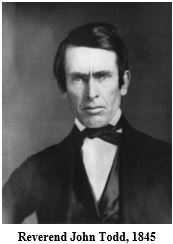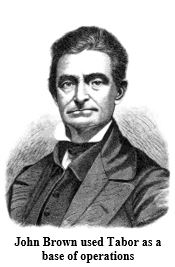Tabor and the Underground Railroad

Tabor was founded by dedicated abolitionists George Gaston, Samuel Adams and Reverend John Todd, men who believed their Christian faith demanded that they fight the injustice of slavery by
providing assistance to any who arrived on their doorstep seeking freedom. As the village’s spiritual leader, Reverend Todd visited the topic regularly in his writings and sermons.
Typical of Todd’s anti-slavery passion was a fiery talk he delivered July 20, 1856, in the sermon titled National Judgment: “God delivered us from British oppression and instead
of freeing the slaves, which, according to the principles upon which our fathers based their right to freedom, were equally entitled to liberty, we held them still in bondage—thus
our fathers took to their bosom the chilled viper.”
When the Kansas Territory exploded in violence after the passage of the Kansas-Nebraska Act, Tabor was thrust into the struggle as a rallying point for Free State supporters moving
south and as a safe haven for armed forces fighting pro-slavery groups within the territory. Civil strife in Kansas coupled with Tabor’s proximity to Missouri, a slave state, ensured
the town would be an important stopping point in Iowa’s Underground Railroad. As did other leaders in the struggle, Ohio abolitionist John Brown began using Tabor as a base of operations.
In the fall of 1856 he brought wounded men to the village for convalescence, stored weapons and supplies in its barns and homes, and trained his volunteers in the city square; his longest
stay was four months, between August and November, 1857.
 Tabor’s first rescue on the Underground Railroad occurred on Independence Day, 1854, when the Dennis family transiting from Mississippi to Utah stopped for the night near the hotel of Jesse West.
The group included an enslaved group of six. Samuel Adams talked quietly to the bondsmen and discovered they were willing and ready to seek freedom, so he organized an escape for that evening.
The group, minus one elderly woman who felt unable to leave, was spirited away and hidden in the barn of George Gaston until conductors (guides) could lead the fugitives toward the cabin of
Charles Toles, located near present day Malvern. Moving north along the East Nishnabotna Valley, the escapees next arrived at the home of Congregational minister George B. Hitchcock in Cass
County, near present day Lewis where they were fed and sheltered. From there the route led due east to abolitionist Quaker communities near Des Moines. The group crossed the Mississippi River
at Davenport heading to the anti-slavery town of Galesburg, Illinois; from there they moved to Chicago where the five were placed on ships transiting the Great Lakes to find freedom in Canada.
The entire journey lasted about a month. Their former owner Mr. Dennis was dogged in his effort to regain his property; he employed slave hunters, offering a reward of $50 per person and $200
for information about those who had helped. He personally tracked the group to Chicago and even returned months later to Tabor where he attacked one of the original conductors with a cane,
almost killing him.
Tabor’s first rescue on the Underground Railroad occurred on Independence Day, 1854, when the Dennis family transiting from Mississippi to Utah stopped for the night near the hotel of Jesse West.
The group included an enslaved group of six. Samuel Adams talked quietly to the bondsmen and discovered they were willing and ready to seek freedom, so he organized an escape for that evening.
The group, minus one elderly woman who felt unable to leave, was spirited away and hidden in the barn of George Gaston until conductors (guides) could lead the fugitives toward the cabin of
Charles Toles, located near present day Malvern. Moving north along the East Nishnabotna Valley, the escapees next arrived at the home of Congregational minister George B. Hitchcock in Cass
County, near present day Lewis where they were fed and sheltered. From there the route led due east to abolitionist Quaker communities near Des Moines. The group crossed the Mississippi River
at Davenport heading to the anti-slavery town of Galesburg, Illinois; from there they moved to Chicago where the five were placed on ships transiting the Great Lakes to find freedom in Canada.
The entire journey lasted about a month. Their former owner Mr. Dennis was dogged in his effort to regain his property; he employed slave hunters, offering a reward of $50 per person and $200
for information about those who had helped. He personally tracked the group to Chicago and even returned months later to Tabor where he attacked one of the original conductors with a cane,
almost killing him.
The first escape would be followed by many others, no two exactly alike but all following the pattern of village residents quickly and quietly responding to fugitives who usually arrived unannounced,
drawing up a plan and enlisting conductors to lead the escapees north and east across Iowa to be transferred to other stations (hiding places), the first stop usually being Reverend Hitchcock’s home
in Lewis. Tabor also had a close relationship with friends and relatives living in the area of Civil Bend, an anti-slavery community southwest of Tabor near the Missouri River. The community, which
included several free black residents, had a well-earned reputation as a safe haven among Underground Railroad supporters in Kansas and Missouri. It was not uncommon for Civil Bend residents to
place runaways into grain wagons, some with false bottoms, moving to Tabor where they would be handed off.
The exact numbers of fugitives who passed through Tabor and other locales will never be known because there are no written records-working with the Underground Railroad was a violation of
federal law and bounty hunters were never far away. Tabor’s residents knew the risks but remained dedicated and vigilant. On Christmas Day, 1856, Martha Todd wrote in a letter to her father,
Ohio Judge Quintus Atkins, that “Our little place has been visited again by a slave catcher. . . We supposed warrants would be obtained to search our houses . . . We feared not their warrants
because of finding [runaways] but because of some firearms placed in Tabor destined for Kansas.”
Reverend Todd describes only five escapes in his autobiography, but there were most certainly many more. The historical record does not mention any fugitive moving through Tabor after 1860,
and once the Civil War started, the nature of Underground Railroad changed from small numbers of runaways to larger groups of refugees migrating north after their liberation by Union forces.
Thank you to Harry Wilkins, Tabor Historical Society for sharing this page.


 Tabor’s first rescue on the Underground Railroad occurred on Independence Day, 1854, when the Dennis family transiting from Mississippi to Utah stopped for the night near the hotel of Jesse West.
The group included an enslaved group of six. Samuel Adams talked quietly to the bondsmen and discovered they were willing and ready to seek freedom, so he organized an escape for that evening.
The group, minus one elderly woman who felt unable to leave, was spirited away and hidden in the barn of George Gaston until conductors (guides) could lead the fugitives toward the cabin of
Charles Toles, located near present day Malvern. Moving north along the East Nishnabotna Valley, the escapees next arrived at the home of Congregational minister George B. Hitchcock in Cass
County, near present day Lewis where they were fed and sheltered. From there the route led due east to abolitionist Quaker communities near Des Moines. The group crossed the Mississippi River
at Davenport heading to the anti-slavery town of Galesburg, Illinois; from there they moved to Chicago where the five were placed on ships transiting the Great Lakes to find freedom in Canada.
The entire journey lasted about a month. Their former owner Mr. Dennis was dogged in his effort to regain his property; he employed slave hunters, offering a reward of $50 per person and $200
for information about those who had helped. He personally tracked the group to Chicago and even returned months later to Tabor where he attacked one of the original conductors with a cane,
almost killing him.
Tabor’s first rescue on the Underground Railroad occurred on Independence Day, 1854, when the Dennis family transiting from Mississippi to Utah stopped for the night near the hotel of Jesse West.
The group included an enslaved group of six. Samuel Adams talked quietly to the bondsmen and discovered they were willing and ready to seek freedom, so he organized an escape for that evening.
The group, minus one elderly woman who felt unable to leave, was spirited away and hidden in the barn of George Gaston until conductors (guides) could lead the fugitives toward the cabin of
Charles Toles, located near present day Malvern. Moving north along the East Nishnabotna Valley, the escapees next arrived at the home of Congregational minister George B. Hitchcock in Cass
County, near present day Lewis where they were fed and sheltered. From there the route led due east to abolitionist Quaker communities near Des Moines. The group crossed the Mississippi River
at Davenport heading to the anti-slavery town of Galesburg, Illinois; from there they moved to Chicago where the five were placed on ships transiting the Great Lakes to find freedom in Canada.
The entire journey lasted about a month. Their former owner Mr. Dennis was dogged in his effort to regain his property; he employed slave hunters, offering a reward of $50 per person and $200
for information about those who had helped. He personally tracked the group to Chicago and even returned months later to Tabor where he attacked one of the original conductors with a cane,
almost killing him.